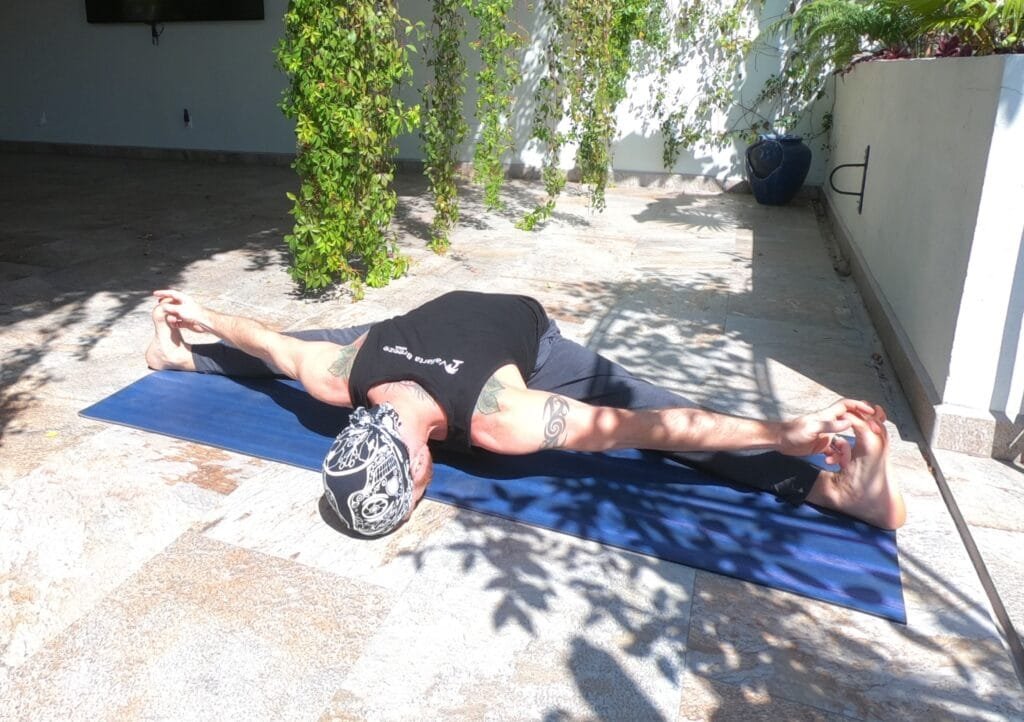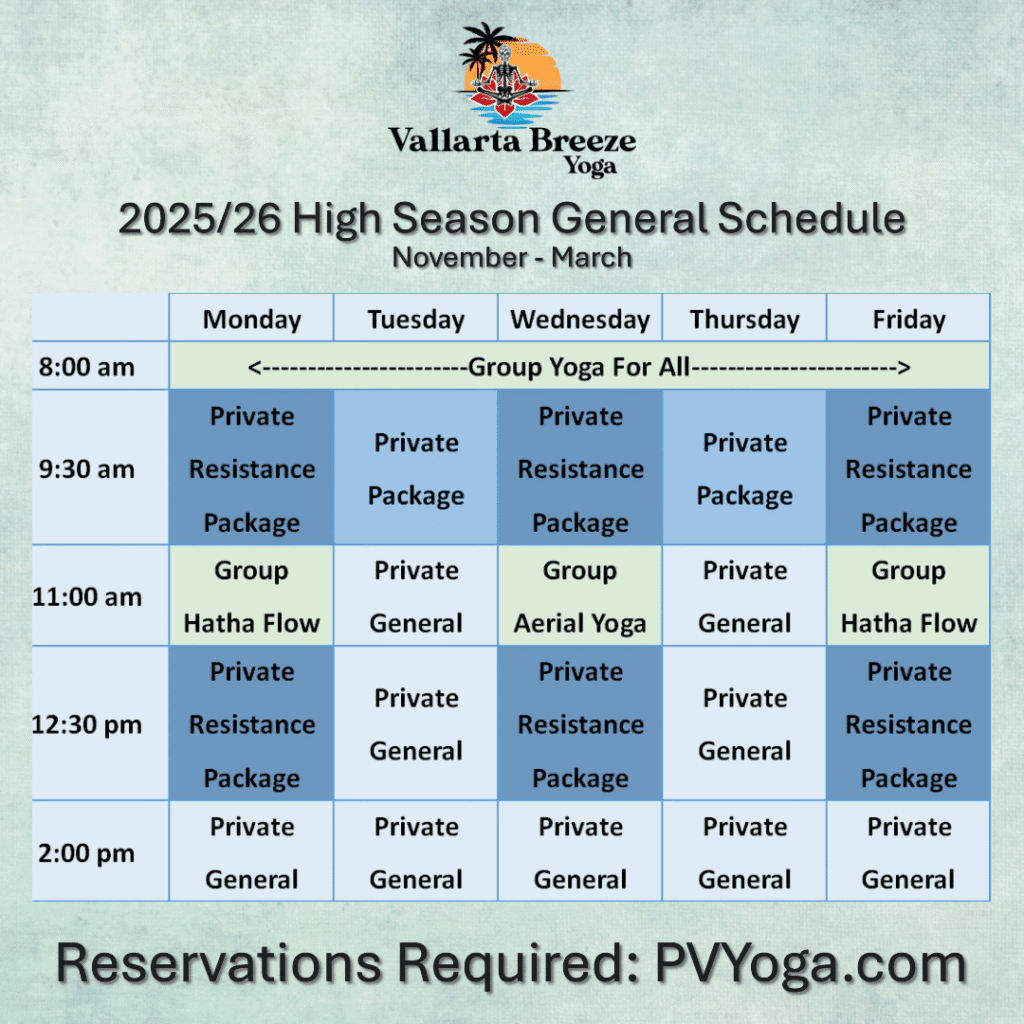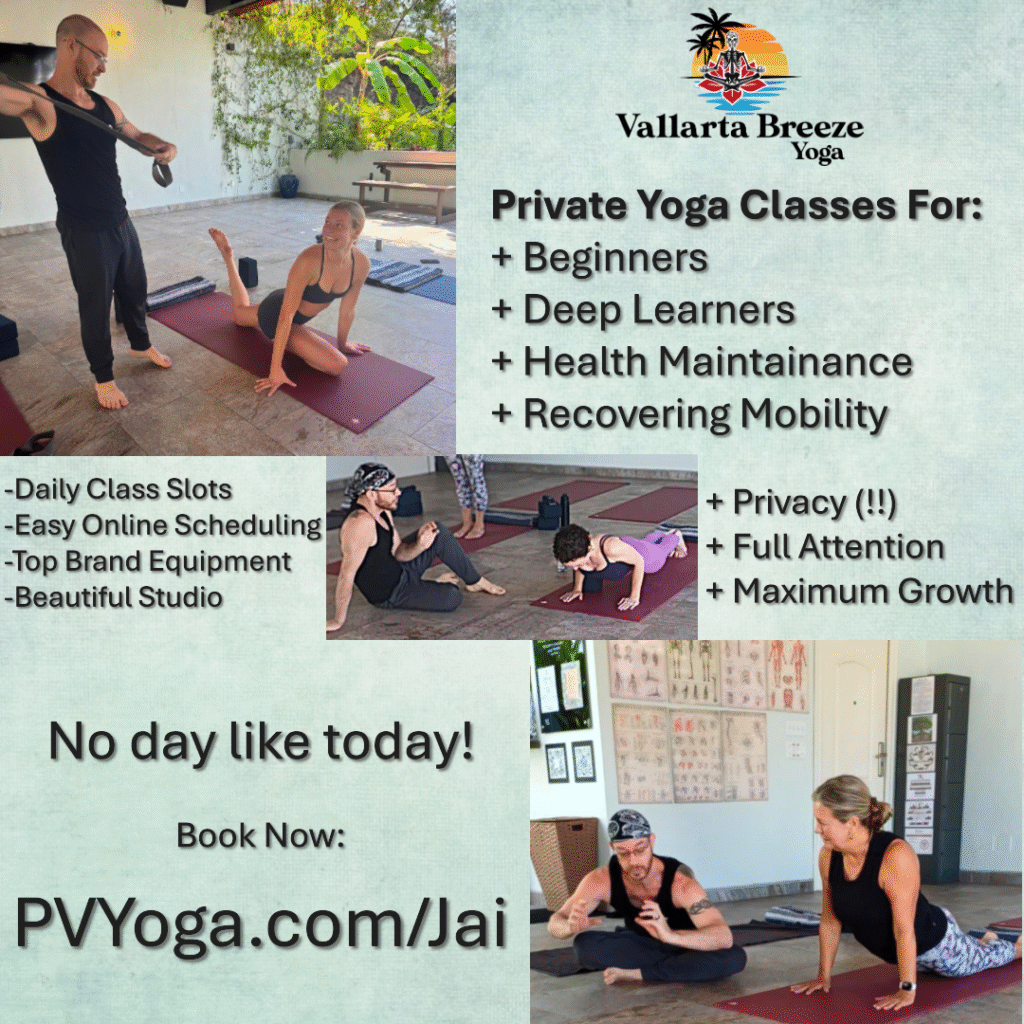Wide-Seated Forward Bend (Upavistha Konasana) aka Pancake
Interesting Fact: Wide-Seated Forward Bend, Upavistha Konasana, or “Pancake” — literally meaning “sitting with legs in an angle”—is a forward bend that stretches the hamstrings, adductors, calves, and lower back, while promoting deep introspection and calm. Though modern yoga pioneers like Iyengar and Sivananda have refined its alignment for contemporary practice, its conceptual roots lie in ancient meditative seating postures. This pose bridges physical flexibility and inner awareness, inviting practitioners to explore both bodily and energetic dimensions.
Historical and Cultural Context
Ancient Foundations: In early yogic traditions, seated postures were central to meditation and pranayama (breath regulation). While Upavistha Konasana does not appear explicitly in early scriptures, its archetypal form is evident in practices detailed in texts like the Hatha Yoga Pradipika and Gheranda Samhita. These works emphasize seated stillness, which cultivates an internal landscape for meditation.
Modern Codification: In the 19th and 20th centuries, as yoga evolved from hidden meditative disciplines into a system of physical postures, teachers began to standardize and name poses. Upavistha Konasana emerged as an expression of both tradition and modern biomechanical awareness, uniting ancient insights with contemporary needs for stability, alignment, and mindful movement.
Etymology and Terminology
- Upavistha (उपविष्ट): Derived from Sanskrit for “to sit” or “to settle,” it underscores the inherent grounding and stability needed in meditation.
- Kona (कोण): Meaning “angle” or “corner,” referencing the wide-angled spread of the legs in the posture.
- Asana (आसन): Translates simply as “pose” or “posture,” the physical manifestation of mental steadiness.
Together, Upavistha Konasana invites you to “sit with your legs forming an angle,” merging physical openness with an invitation to inner exploration.
Anatomical Breakdown and Alignment
In Upavistha Konasana, you sit with your legs extended in a V‑shape and reach forward from the hips. This forward bend offers a deep stretch along the hamstrings and inner thighs, while engaging the core and supporting spinal muscles to maintain an elongated torso.
Musculature Involved
| Muscle Group | Primary Muscles Involved | Role in Upavistha Konasana |
|---|---|---|
| Hamstrings | Biceps Femoris, Semitendinosus, Semimembranosus | Lengthen and stretch, releasing tension along the back of the thighs |
| Adductors | Adductor Longus, Adductor Brevis, Adductor Magnus, Gracilis | Open the inner thighs, facilitating a wider leg spread |
| Calf Muscles | Gastrocnemius, Soleus | Assist in supporting the lower leg extension and provide stability |
| Spinal Extensors | Erector Spinae, Multifidus | Maintain an elongated spine and support a stable forward bend |
| Core Muscles | Rectus Abdominis, Obliques, Transversus Abdominis | Stabilize the torso and protect the lower back during the forward fold |
| Hip Flexors | Iliopsoas | Subtly support hip stability as you hinge from the pelvis |

Step-by-Step Practice Guide
- Set-Up:
- Starting Position: Sit on your mat with your legs extended in a wide V. If your hips feel tight, use a thin folded blanket or cushion beneath the sitting bones to encourage a slight forward tilt.
- Grounding: Press gently through your sitting bones to establish a stable base.
- Establish Alignment:
- Spine and Chest: Inhale deeply to lengthen your spine, ensuring each vertebra creates space.
- Leg Placement: Allow your legs to open gradually, with the inner thighs lightly pressing downward toward the floor.
- Initiate the Forward Bend:
- Hip Hinge: As you exhale, hinge forward from the hips rather than rounding the back. Lead with your chest to maintain natural spinal curves.
- Arm Placement: Reach your hands toward the floor or slide them along your legs, using them to guide the movement without forcing the stretch.
- Integrate Dristi (Gaze):
- Focus Point: Choose a soft, steady gaze. You may focus on a spot on the mat or close your eyes to deepen your inward focus. Dristi helps anchor your balance and centers your mind.
- Engage Bandhas (Energy Locks):
- Mula Bandha: Gently contract the pelvic floor muscles to create a sense of stability and direct pranic energy upward.
- Uddiyana Bandha: Lightly draw the lower abdomen inward and upward, engaging your core to protect the lumbar region.
- Steady Your Breath:
- Breathing Technique: Maintain slow, deep, even breaths through the nose—inhale to lengthen and prepare, exhale to deepen the fold. A steady breath fosters relaxation and energetic balance.
- Hold and Explore:
- Duration: Sustain the pose for 30–60 seconds, allowing the muscles to relax further with each exhalation.
- Mindful Awareness: Notice the sensations in your hamstrings, inner thighs, and lower back, and allow your focus to wander inward with each breath.
- Counterpose:
- Transition Out: Slowly lift your torso back to an upright position. Transitioning into a gentle back-bend (such as Setu Bandha Sarvangasana – Bridge Pose) or a mild seated twist can help neutralize the forward bend, smoothly reawakening the spine.

Pro Tips:
- Warm-Up: Engage in preparatory movements—such as gentle hip openers or dynamic stretches—to ready the hamstrings and inner thighs.
- Use Props: If reaching the floor is challenging or if you experience discomfort, use yoga blocks under the hands or a bolster for support.
- Progress Gradually: Allow the range of your forward bend to deepen slowly over time. Respect your body’s limits, and avoid forcing any movement.
- Mindful Focus: Keep your attention on a steady dristi and a smooth, deep breath to support balance and deepen your internal awareness.
- Transition Smoothly: Prepare and practice an appropriate counterpose to evenly distribute the work between contracted and extended muscles.
Physical Benefits
- Deep Stretch: Enhances flexibility in the hamstrings, calves, and inner thighs.
- Spinal Decompression: Encourages elongation of the back, relieving stiffness and tension.
- Core Engagement: Activates and tones the midline, promoting better posture and stability.
- Hip Opening: Gently works the muscles around the pelvis and hips, potentially alleviating lower back discomfort.
Energetic Benefits
- Calms the Mind: The forward fold helps induce a meditative state, fostering mental quietude.
- Balances Prana: The subtle engagement of bandhas aids in regulating the flow of energy (prana) through the body.
- Stimulates Digestion: The gentle compression of the abdomen can awaken digestive fire (Agni) and restore vitality.
- Promotes Inner Awareness: The integration of breath, gaze, and movement deepens the connection between body and mind.
Contraindications
- Lower Back Injuries: Those with acute back pain, herniated discs, or significant lower back injuries should practice cautiously, maintaining a neutral spine or using modifications.
- Hamstring Strains: Overstretching tight or strained hamstrings may lead to injury. Use props or reduce the depth of the fold if needed.
- High Blood Pressure: Deep forward bends can increase intra-abdominal pressure. Modify the pose and engage in gentle breathing if you have high blood pressure.
- Pregnancy: As with any forward bend, pregnant practitioners should consult a healthcare provider or an experienced teacher before practicing and modify the pose accordingly.
Counterpose
After holding Upavistha Konasana, it is essential to realign the body and rebalance the muscle groups:
- Gentle Back-Bend: Carefully lift your torso back to an upright position. Transition into a mild back-bending posture, such as Bridge Pose or a gentle seated twist, to release the tension in the hamstrings and lower back.
- Spinal Articulation: Allow your spine to articulate naturally as you move away from the forward fold. This counterbalance prevents stiffness and promotes healthy movement in opposing muscle groups.
Upavistha Konasana goes far beyond a simple physical stretch—it is a doorway to inner exploration and energetic balance. Rooted in ancient practice and refined by modern biomechanics, this pose simultaneously enhances flexibility, stability, and mental clarity. By integrating mindful drishti, active bandhas, and deliberate breathwork, you can transform your practice into a meditative journey that connects body, mind, and spirit.
Advanced entry from Standing Wide Legged Forward Fold
Continue your growth with the Vallarta Breeze Yoga Puerto Vallarta Yoga Studio!
Whether you’re looking to dive deeper into the physical practice of yoga, The Vedas, Upanishads, Yoga Sutras, or would like to explore our blog, we have a wealth of information available for you! Better yet, join us here in the Vallarta Breeze Yoga Puerto Vallarta Yoga studio, or practice with us online! we’re excited to continue this journey with you. See you on the mat!



